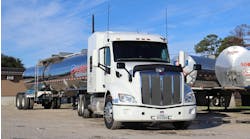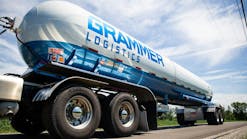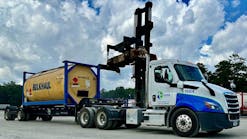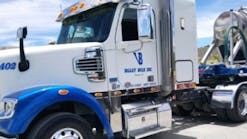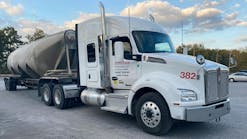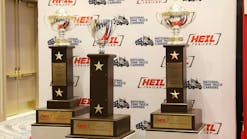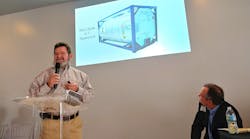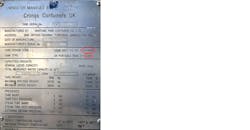Inspection expert sheds light on current requirements for identifying portable tanks
The requirements for marking portable tank containers have changed in many ways during the last decade.
Some of these changes still are causing consternation today.
To help clear up some confusion—and keep intermodal shippers out of trouble—Anthony Bova, a general manager with Silver/CIMS LLC Inspection Service, provided a regulatory and technical compliance update for containers, including T-codes, ‘S’ markings and ACEP, during the Intermodal Tank Container Association’s 2018 Intermodal Bulk Liquid Symposium in El Lago, Texas.
“These are changes that have been implemented over the last five to seven years, and even the oldest of the marking requirements are still not being applied correctly in a lot of instances,” Bova said.
T-codes, ‘S’ markings
Tank container classification codes, or “T-codes,” like the common T11 designation, are instructions that must be inscribed on all portable tanks manufactured after January 2014. Tanks made prior to January 2014 are expected to have a T-code applied at the next regulatory inspection date.
These codes are required for non-refrigerated and refrigerated gas tanks, too.
“By now, every tank that’s out there should have a tank instruction with a T-code on it, but that’s not always the case,” he said.
The codes are recorded on the tank’s data plate, the side of the tank or both.
“The T-code is determined by a comparison of tank test pressure, minimum shell thickness, in reference steel … the pressure relief valve, whether it’s the normal pressure relief valve or one with the bursting disc, and … the bottom outlet, whether it’s fitted or not, and if it is, the number of closures,” Bova said.
A T-code chart, along with many other helpful links, is available at tankcontainer.com.
Around the same time T-codes were implemented, another change mandated that all tanks fitted with baffles, aka surge plates, which divide compartments into sections, are marked with an ‘S’ at capacity.
“Just like the T-codes, any tank that’s on the road now, with baffles, should have the ‘S’ marking at the capacity,” Bova said. “And a lot of these tanks are modified after the fact, so it’s not only tanks that have been manufactured with baffles, but the ones that have had baffles installed, too.”
ISO codes, ACEP
ISO code changes also continue to spark anxiety.
Some people might think a tank marked with an older 22T6 ISO code is a T6 tank, when it’s actually a T11.
“What was happening is people were confusing the T6 on the ISO code with the T-code,” Bova hypothesized.
Now the ‘T’ in the ISO code is a ‘K,’ which represents pressurized tank containers.
“It’s a little less confusing,” he maintained.
Some confusion persists, however, because tanks with older codes still are out there.
“If you’ve got tanks operating with older codes, like 20T6 or 22T6, there isn’t a requirement to change them,” Bova said. “You can still run them under those old codes. But if you must replace that code for any reason, whether it’s damaged or illegible … it’s best to go ahead and apply the new codes.”
There is one exception to the rule for older tanks.
If a tank’s stacking weight is less than 192,000 kilograms, it must be marked with a ‘D’ identifying its lower threshold. And whereas ISO codes on standard tanks generally appear on the sides and rear only, tanks with lower stacking weights also must be marked on top and at front.
Bova recommended using the Approved Continuous Examination Program (ACEP) for container safety compliance.
With an ACEP approval, the container’s next inspection date isn’t required on the CSC (Container Safety Convention) plate. Without an ACEP number, the next safety inspection date is five years from the tank manufacture date, which often is different from the next regulatory inspection date.
“If you’re an operator or a leasing company and you’re not operating under an ACEP program, consider doing so,” Bova said.
“That’s going to save you from a lot of problems.”
RID/ADR
Bova also touched on the European agreements concerning the international carriage of dangerous goods by rail (RID) and by road (ADR), and the frequently confounding difference between tank containers approved under Chapters 6.7 and 6.8 in the United Nations Model Regulations.
“This is probably one of the most misunderstood and mismarked approvals,” Bova said.
Chapter 6.7 refers to the inspection and testing of portable tanks and UN multiple-element gas containers (MEGCs). Chapter 6.8 references tank containers and tank swap bodies—Bova considers older IM tanks, tank containers—and even includes a note saying see 6.7 for portable tanks and MEGCs.
“For some reason, they still feel the need to approve them under both 6.7 and 6.8,” he said.
Only portable tanks approved under 6.8 can use ADR codes, like the familiar L4BN marking, which define the container’s type, minimum calculation pressure in bar, discharge and relief requirements.
One exception: Tanks manufactured to IMO portable regulations before 2003.
“They can display the ADR code, if they want to put it on there, but I wouldn’t recommend it,” Bova said.
The problem is its difficult to tell a 6.7 from a 6.8 tank.
Most look identical, especially to the untrained eye, Bova said, and, for all practical purposes, they are the same.
“There are some minor differences in inspections and production,” Bova said. “There’s a requirement for the L4BN tank to use European steel (for example). But if you put these two tanks side by side, at a glance you’re not going to tell the difference, unless you notice the markings.”
And when it comes to markings, Bova recommends doublechecking the basics at every opportunity.
“It’s better to catch a problem ahead of time instead of having your tank held up in a port or stopped on the side of the road,” he said. “That’s been happening a lot, especially with the L4BN in Europe.”
